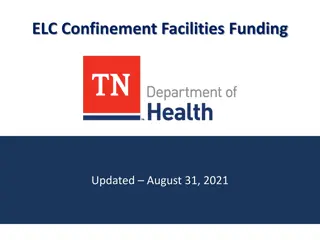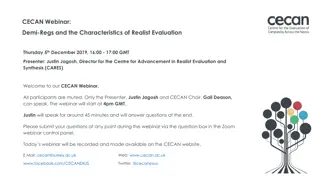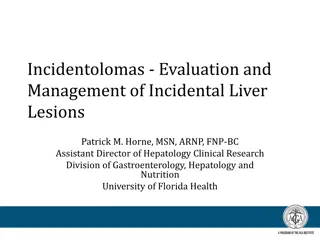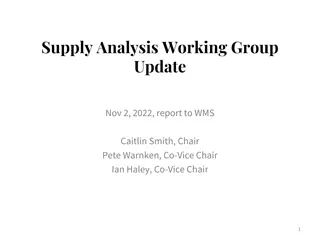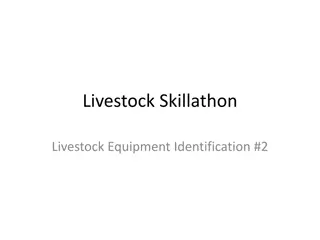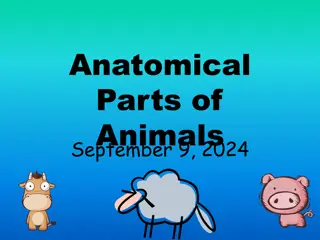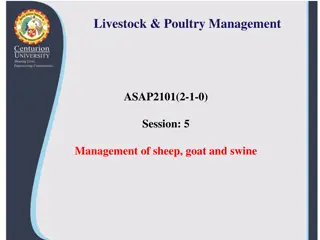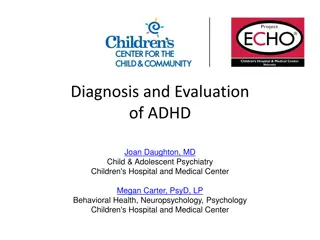Evaluation of Settje Analysis of Hog Confinement Lot Findings
Goss & Associates evaluated Settje's analysis of a hog confinement lot and found discrepancies in job creation estimates, local tax impacts, and cost assessments including factors like increased local government costs and impacts on infrastructure. Settje's errors include exaggerated past economic performance in Cherry County and faulty assumptions like incorrect methodology and failure to identify the source of workers. The comparison of economic performance in Cherry County reveals misstatements in population growth, job growth, unemployment rate, labor force participation, and wage growth.
Download Presentation

Please find below an Image/Link to download the presentation.
The content on the website is provided AS IS for your information and personal use only. It may not be sold, licensed, or shared on other websites without obtaining consent from the author. Download presentation by click this link. If you encounter any issues during the download, it is possible that the publisher has removed the file from their server.
E N D
Presentation Transcript
Evaluation of Settje Analysis of Hog Confinement Lot ERNIE GOSS, PH.D., GOSS & ASSOCIATES 28 DECEMBER 2020
Summary of Goss major findings: SETTJE RELIES ON THE UNL STUDY BUT THEIR ESTIMATES DO NOT ALIGN WITH THE UNL STUDY UNL study (using Implan-see appendix for definition) estimated 2.08 jobs created for each 1,000 head of swine. SETTJE estimated 4.25 jobs created for each 1,000 head of swine. UNL study estimated that each head of hog added in the county would create $4.70 in added local tax collections compared to a much higher $28.78 for each head of cattle added in the county. 1. SETTJE FAILS TO ESTIMATE LOCAL GOVERNMENT COST INCREASE DUE TO NEW WORKERS AND FAMILIES MOVING INTO CHERRY COUNTY FROM OUTSIDE. SETTJE estimates that 80 new workers would be hired to work in the lot. This would result in as many as 50 new students attending the public school system, many potentially needing ESL tutoring. SETTJE assumes that this additional cost is $0. SETTJE fails to estimate the costs of new roads, and or, increases in public road repairs. Even without new roads/schools and other new infrastructure, the swine lot would cost local taxpayers an estimated $81,131 per year in added local taxes. SETTJE s estimates do not account for hidden costs such as decreased property values, negative impacts on outdoor recreation and tourism resulting from a hog confinement lot. A CATTLE LOT EMPLOYING THE SAME NUMBER OF WORKERS (80 IN THIS CASE) WOULD CREATE: 4.34 times the total impact of a swine facility 1.86 times the labor income (i.e. wages and salaries plus self-employment income) 1.63 times the total jobs of a swine facility 1.65 times the state and local taxes of a swine facility 2. 3. 4.
Summary of Settje Errors or Faulty Assumptions: 1. SETTJE EXAGGERATED AND MISCALCULATED CHERRY COUNTY S PAST ECONOMIC PERFORMANCE IN TERMS OF: *POPULATION (SEE SLIDE 5) *JOB GROWTH (SEE SLIDE 6) *UNEMPLOYMENT RATE (SEE SLIDE 7) *LABOR FORCE PARTICIPATION (SEE SLIDE 8) *WAGE GROWTH (SEE SLIDE 9) 2. SETTJE USED THE INCORRECT METHODOLOGY *IMPLAN MULTIPLIER FOR HOG OPERATIONS, JOB = 1.19, OUTPUT=1.22 (SEE SLIDE 12) *SETTJE USES A ECONOMIC BASE MULTIPLIER OF 6.7 (GOSS CALCULATES AS 1.44, SEE SLIDE 12) *SETTJE USES A MULTIPLIER OF 4 TO 7. 3. SETTJE FAILS TO ACCOUNT FOR INCREASES IN LOCAL GOVERNMENT COSTS. *HOG OPERATION IS EXPECTED TO INCREASE LOCAL GOVERNMENT TAX COLLECTIONS BY $220,424 (SEE SLIDE 13) *HOG OPERATION IS EXPECTED TO INCREASE LOCAL GOVERNMENT COSTS BY $81,131 (SEE SLIDE 13) 4. SETTJE FAILS TO IDENTIFY THE SOURCE OF THE 80 WORKERS (SEE SLIDE 13). *IF WORKERS COMMUTE FROM OUTSIDE THE COUNTY, SETTJE ECONOMIC IMPACTS IN CHERRY COUNTY ARE TOO HIGH SINCE WAGES WILL GO TO OTHER COUNTIES. *IF WORKERS MOVE FROM OTHER COUNTIES, STATES OR NATIONS, SETTJE FAILS TO ACCOUNT FOR THE COST TO PUBLIC INFRASTRUCTURE SUCH AS SCHOOLS. *
SETTJE MIS-STATES, OR INACCURATELY DEPICTS CHERRY COUNTYS PAST ECONOMIC PERFORMANCE Comparison of Cherry County s Economic Performance (Slides 5-9)
Performance metric: Population growth, 2010 to 2019 % change 2010-2019Compound annual Annual 2010 1,829,542 1,147,242 326,562 355,738 5,694 Annual 2019 1,934,408 1,264,667 326,502 343,239 5,689 Geography growth rate (CAGR) 0.6% 1.1% 0.0% -0.4% 0.0% 5.7% 10.2% 0.0% -3.5% -0.1% Statewide Metro counties Micropolitan counties Non-metro or micro counties Cherry County Source: U.S. Census Bureau, Population Division The proper cohort for Cherry County are similar counties in the state of Nebraska. This requires classification of counties into the following buckets; Metro Counties (counties in a metropolitan statistical area); Micro Counties (counties in a micropolitan statistical area) and the balance of the state (counties in neither a MSA nor a MicroSA). Such a classification allows for a more robust, complete understanding of Cherry County performance, as MSAs are significantly larger and MicroSAs are centered around first-class cities such as Hastings, Kearney and Norfolk. From 2010 to 2019 Cherry County population declined by a modest 0.1 percent, which compares favorably to the Non-metro or micro counties group (-3.5 percent) and is on par with the Micropolitan group (0.0 percent) Cherry County outperformed the cohort group and is on par with the Micro-county group.
Performance metric: Job growth, 2010 to 2019 % change 2010- 2019 9.5% 11.6% 3.7% 1.4% 1.7% Annual 2010 896,936 596,779 153,019 133,647 2,250 Annual 2019 982,504 665,831 158,639 135,568 2,289 Geography CAGR 1.0% 1.22% 0.40% 0.2% 0.2% Statewide Metro counties Micropolitan counties Non-metro or micro counties Cherry County Source: Bureau of Labor Statistics, QCEW From 2010 to 2019, Cherry County labor market performance outpaced its cohort group, increasing total jobs by 1.7 percent compared to 1.4 percent for the other non-metro or micro counties. Cherry County outperformed the cohort group.
Performance metric: Unemployment rate, 2010-19 Unemployment rate comparison: Cherry County vs. County Classifications, 2010 to 2019 (%) The unemployment rate in Cherry County was lower compared to all county classifications for the 2010 to 2019 period. 5.0% Metro Micro Non-metro or micro Cherry County 4.5% 4.0% Cherry County s average unemployment rate was 2.6 percent, 70 basis points below the cohort group rate. 3.5% 3.0% 3.0% 3.0% 2.9% 2.8% Cherry County outperformed all county groups. 2.4% 2.4% 2.5% 2.3% 2.3% 2.2% 2.2% 2.0% 2010 2011 2012 2013 2014 2015 2016 2017 2018 2019
Performance metric: Labor force participation rate (2019) Geography Participation rate Statewide 69.7% Metro counties 71.3% Micropolitan counties 68.1% Non-metro or micro counties 65.6% Cherry County 71.2% Cherry County works! Source: U.S. Census, American Community Survey Cherry County s labor force participation rate (71.2 percent) exceeds both its cohort group and the micro-county group. It is essentially on par with the metro rate. Is labor capacity an issue for Cherry County? Note: The U.S. Census reports that 25 percent of workers employed in Cherry County commute from outside of the county (Longitudinal Employer-Household Dynamics, U.S. Census). Cherry County outperformed the cohort group and the Micro-county groups. Cherry County is on par with the Metro-county group.
Performance metric: Wage growth, 2010 to 2019 Compound annual growth rates (CAGR) 2.8% 2.6% 2.8% 3.0% 3.4% Annual 2010 Annual 2019 Geography % change 2010-2019 Statewide Metro counties Micropolitan counties Non-metro or micro counties Cherry County 37,324 39,849 32,195 30,049 23,600 47,854 50,386 41,287 39,105 31,792 28.2% 26.4% 28.2% 30.1% 34.7% Source: Bureau of Labor Statistics, QCEW From 2010 to 2019, Cherry County wages grew 34.7 percent, easily outdistancing all county classification groups. Its compound annual growth rate was 3.4 percent for the 10 years ending in 2019. Wages support the bulk of consumer household spending and are not subject to concerns regarding household type or size that can create statistical noise in other income measures, such as mean or median household income. Cherry County outperformed all county groups.
Settje used incorrect methodology (Slides 11-13)
Settjes use of base multiplier methodology The base multiplier methodology is a blunt instrument that assumes base industries are homogeneous with respect to economic impact. Fails to follow-the-money and does not provide detailed, robust analysis. Industry impacts vary considerably: wages vary, input costs vary, transportation costs vary and productivity varies all influence the flow of income in the economy. The 6.7 multiplier stated by Settje does not conform with the base multiplier methodology. The multiplier calculated using standard base multiplier methodology results in a significantly smaller employment multiplier. Multiplier range: 1.44 (includes all non-disclosed industries in the denominator) to 2.00 (excludes all non-disclosed industries from the denominator) (Settje uses a multiplier of 4-7 which is well outside the bounds of believability) Base multiplier, Cherry County (2010-2019) 207 415 2.00 Change in total farm and private employment with Location quotient (LQ > 1.00) LQ > 1.00 indicates industry is exporting Change in total farm, government and private employment Employment multiplier using Base Mult. Methodology 288 415 1.44 Change in total farm and private employment with LQ > 1.00 Change in total farm, government and private employment Employment multiplier using Base Mult. Methodology Methodology source: PropertyMetrics.com (web-based commercial real estate analysis software co.) LQ = (% of Cherry county industry employment) / % of U.S. industry employment
IMPLAN multiplier system: Detailed, robust results for Cherry County Comparison of 80 worker swine facility with an 80 worker cattle lot Animal production: swine Animal production: cattle Difference: Swine to cattle Annual impact (2020 dollars) $10,719,400 $6,631,377 $1,148,031 $953,890 95.4 $863,551 $46,542,818 $12,140,502 $2,866,183 $1,044,297 155.6 $2,697,399 Output (sales at all stages of production) Value-added to regional economy Employee wage and salary income Small-business owner income Total jobs (direct+indirect+induced) State and local tax revenue -77% -45% -60% -9% -39% -68% Source: Goss and Associates using the IMPLAN multiplier system IMPLAN multiplier system follows the money from direct company spending to additional business-to-business spending to employee household spending. IMPLAN uses multipliers that account for leakages in income (e.g., payments for taxes). IMPLAN sector for hog confinement lots is sector 14 (first column in the table above) the employment multiplier for CHERRY COUNTY is 1.19 (note: expanding geography coverage like NPPD study over multiple non-metro counties will allow for expanded economic activity within the geo and a larger employment multiplier). Also, the 2002 NPPD study may have used TYPE II multipliers that do not account for leakages such as taxes. Value-added per direct employee (I believe similar measure to NPPD study) is $69,150.85 ($5,532,068 direct value-added/80 employees). For each $1 million in sales == 9.1 jobs are directly impacted [80 direct jobs/($8,796,231 output/$1,000,000)]. Settje may slide in cattle (livestock) impacts for swine as table above presents the impacts are significantly different: All impacts are significantly less for swine production compared to cattle production. Analysis for cattle production can not be used as a proxy for swine production.
IMPLAN multiplier system: Fiscal impact, Cherry County (2020 $$s) Animal Production: Swine production Sales tax Property tax Individual income tax Corporate income tax Other taxes and fees Total tax revenue State $118,870 $0 $38,937 $36,530 $17,014 $211,351 Local $24,347 $152,326 $0 $0 $43,751 $220,424 Total $143,217 $152,326 $38,937 $36,530 $60,765 $431,775 Type Expenditure ($s) State government costs $45,636 Local government costs $81,131 Total government costs $126,767 Source: Goss and Associates using the IMPLAN multiplier system Source: Goss and Associates using the IMPLAN multiplier system Total local tax revenue are estimated to increase by $220,424, annually activity at the project will increase local government expenditures by $81,131, annually. Factors potentially impacting the local fiscal impact: Labor demand at the project is met by commuters from outside of the county: This could result in fiscal leakage from the county, resulting in lower than estimated sales, property and other tax collections. Labor demand at the project is met by in-migration of workers from outside of the county: This could result in greater than estimated local government cost, especially for local school districts.
What is Implan? IMPLAN is an economic impact assessment software system. The system was originally developed and is now maintained by the Minnesota IMPLAN Group (MIG). It combines a set of extensive databases concerning economic factors, multipliers and demographic statistics with a highly refined and detailed system of modeling software. IMPLAN allows the user to develop local-level input-output models that can estimate the economic impact of new firms moving into an area as well as the impacts of professional sports teams, recreation and tourism, and residential development. The model accomplishes this by identifying direct impacts by sector, then developing a set of indirect and induced impacts by sector through the use of industry-specific multipliers, local purchase coefficients, income-to-output ratios, and other factors and relationships. http://cier.umd.edu/RGGI/documents/IMPLAN.pdf WHAT IS THE ECONOMIC BASE MODEL? THE ECONOMIC BASE MODEL SAYS THAT THERE IS SOME EMPLOYMENT IN A REGION WHICH IS SERVING THE LOCAL MARKET AND SOME EMPLOYMENT WHICH IS INDEPENDENT OF THE LOCAL MARKET. THIS LATTER EMPLOYMENT IS CALLED BASIC EMPLOYMENT. THE OTHER EMPLOYMENT IS CALLED LOCAL-MARKET-SERVING EMPLOYMENT. THIS MODEL ASSUMES THAT THE RELATIONSHIP BETWEEN THE BASE AND NON-BASE REMAINS CONSTANT WITH BOTH SMALL AND LARGE CHANGES IN THE ECONOMY.



